Individual Report: Information Technology and TESCO's Success
VerifiedAdded on 2023/02/01
|12
|3091
|88
Report
AI Summary
This individual report examines the significant role of Information Technology (IT) in the success of TESCO, a multinational retail giant. The report begins with an introduction highlighting IT's importance in modern business operations, particularly in handling complex retail processes. A literature review explores how IT has revolutionized TESCO's operations, including stock control, supplier management, and distribution, with specific examples like the TESCO Clubcard and cloud computing. The report also addresses ethical and social issues related to IT in the retail industry, such as cyber-crime, information system security, and electronic waste. It differentiates between various networking technologies used by TESCO, including LAN, MAN, WAN, wireless, and inter-networks, and discusses the importance of the Internet and intranet for information sharing and communication. Finally, the report outlines the different stages of system development, from planning to maintenance, emphasizing the need for effective software development in the retail sector. The document is contributed by a student to be published on the website Desklib, which provides all the necessary AI based study tools for students.

Individual Report
Paraphrase This Document
Need a fresh take? Get an instant paraphrase of this document with our AI Paraphraser
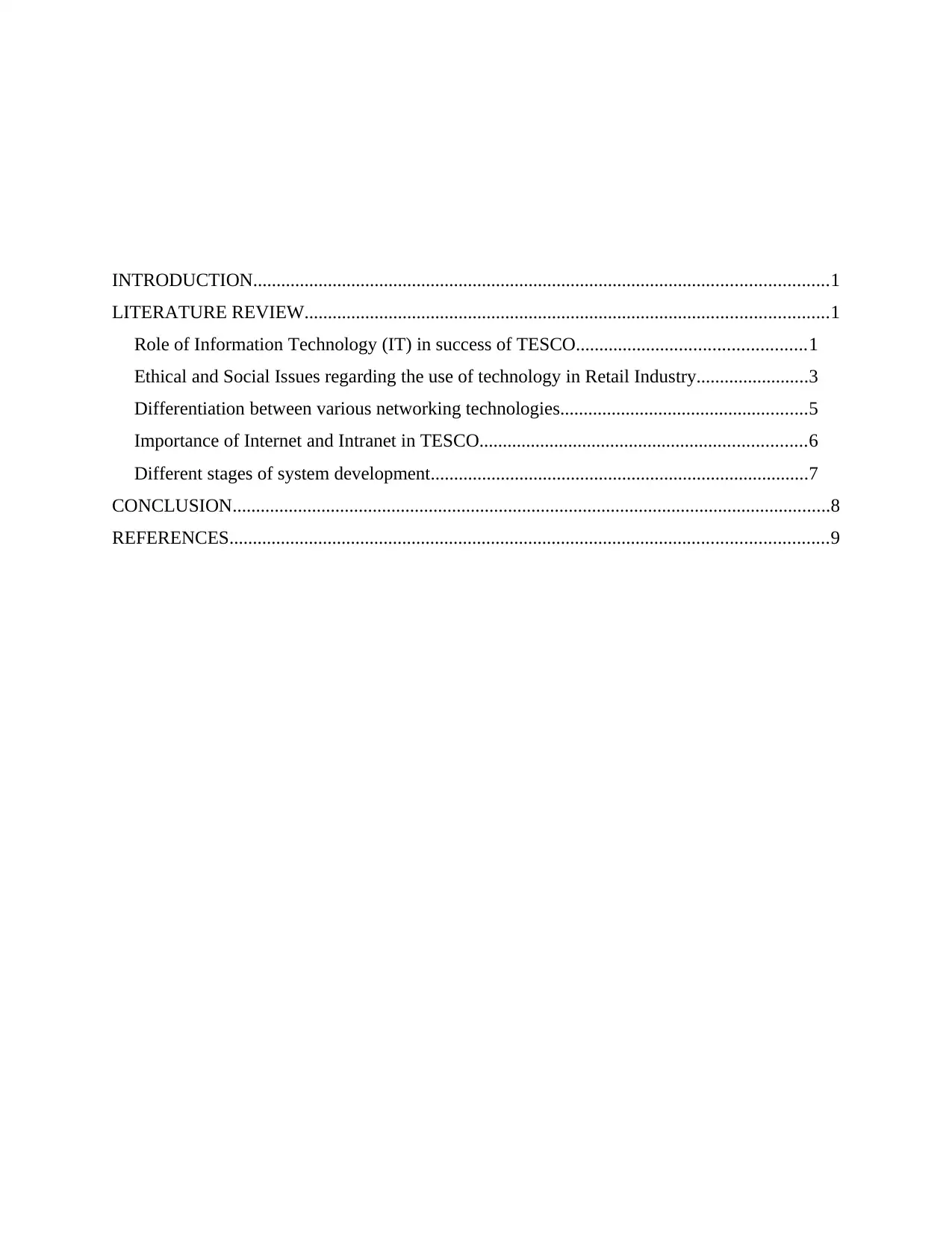
INTRODUCTION...........................................................................................................................1
LITERATURE REVIEW................................................................................................................1
Role of Information Technology (IT) in success of TESCO.................................................1
Ethical and Social Issues regarding the use of technology in Retail Industry........................3
Differentiation between various networking technologies.....................................................5
Importance of Internet and Intranet in TESCO......................................................................6
Different stages of system development.................................................................................7
CONCLUSION................................................................................................................................8
REFERENCES................................................................................................................................9
LITERATURE REVIEW................................................................................................................1
Role of Information Technology (IT) in success of TESCO.................................................1
Ethical and Social Issues regarding the use of technology in Retail Industry........................3
Differentiation between various networking technologies.....................................................5
Importance of Internet and Intranet in TESCO......................................................................6
Different stages of system development.................................................................................7
CONCLUSION................................................................................................................................8
REFERENCES................................................................................................................................9

++
⊘ This is a preview!⊘
Do you want full access?
Subscribe today to unlock all pages.

Trusted by 1+ million students worldwide
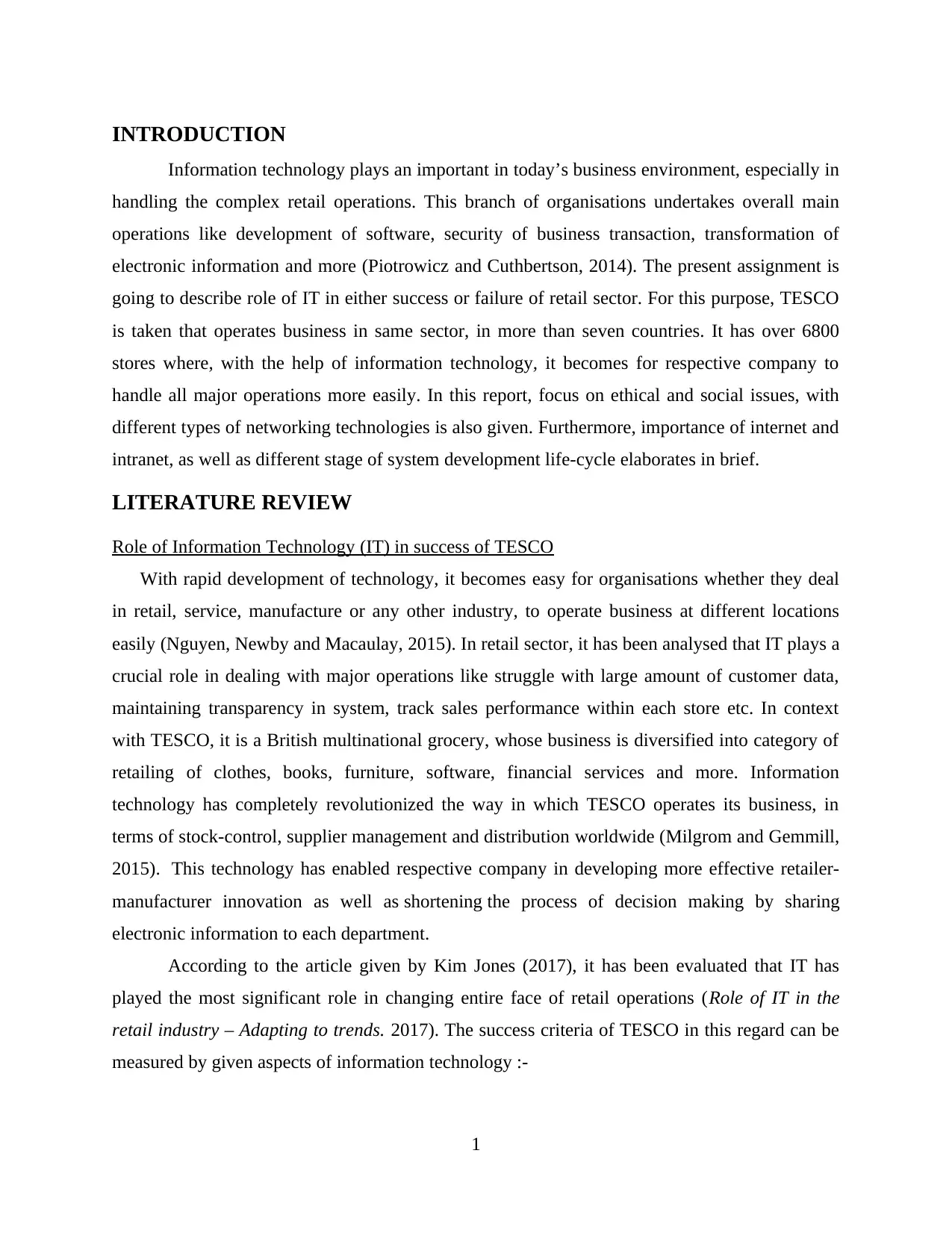
INTRODUCTION
Information technology plays an important in today’s business environment, especially in
handling the complex retail operations. This branch of organisations undertakes overall main
operations like development of software, security of business transaction, transformation of
electronic information and more (Piotrowicz and Cuthbertson, 2014). The present assignment is
going to describe role of IT in either success or failure of retail sector. For this purpose, TESCO
is taken that operates business in same sector, in more than seven countries. It has over 6800
stores where, with the help of information technology, it becomes for respective company to
handle all major operations more easily. In this report, focus on ethical and social issues, with
different types of networking technologies is also given. Furthermore, importance of internet and
intranet, as well as different stage of system development life-cycle elaborates in brief.
LITERATURE REVIEW
Role of Information Technology (IT) in success of TESCO
With rapid development of technology, it becomes easy for organisations whether they deal
in retail, service, manufacture or any other industry, to operate business at different locations
easily (Nguyen, Newby and Macaulay, 2015). In retail sector, it has been analysed that IT plays a
crucial role in dealing with major operations like struggle with large amount of customer data,
maintaining transparency in system, track sales performance within each store etc. In context
with TESCO, it is a British multinational grocery, whose business is diversified into category of
retailing of clothes, books, furniture, software, financial services and more. Information
technology has completely revolutionized the way in which TESCO operates its business, in
terms of stock-control, supplier management and distribution worldwide (Milgrom and Gemmill,
2015). This technology has enabled respective company in developing more effective retailer-
manufacturer innovation as well as shortening the process of decision making by sharing
electronic information to each department.
According to the article given by Kim Jones (2017), it has been evaluated that IT has
played the most significant role in changing entire face of retail operations (Role of IT in the
retail industry – Adapting to trends. 2017). The success criteria of TESCO in this regard can be
measured by given aspects of information technology :-
1
Information technology plays an important in today’s business environment, especially in
handling the complex retail operations. This branch of organisations undertakes overall main
operations like development of software, security of business transaction, transformation of
electronic information and more (Piotrowicz and Cuthbertson, 2014). The present assignment is
going to describe role of IT in either success or failure of retail sector. For this purpose, TESCO
is taken that operates business in same sector, in more than seven countries. It has over 6800
stores where, with the help of information technology, it becomes for respective company to
handle all major operations more easily. In this report, focus on ethical and social issues, with
different types of networking technologies is also given. Furthermore, importance of internet and
intranet, as well as different stage of system development life-cycle elaborates in brief.
LITERATURE REVIEW
Role of Information Technology (IT) in success of TESCO
With rapid development of technology, it becomes easy for organisations whether they deal
in retail, service, manufacture or any other industry, to operate business at different locations
easily (Nguyen, Newby and Macaulay, 2015). In retail sector, it has been analysed that IT plays a
crucial role in dealing with major operations like struggle with large amount of customer data,
maintaining transparency in system, track sales performance within each store etc. In context
with TESCO, it is a British multinational grocery, whose business is diversified into category of
retailing of clothes, books, furniture, software, financial services and more. Information
technology has completely revolutionized the way in which TESCO operates its business, in
terms of stock-control, supplier management and distribution worldwide (Milgrom and Gemmill,
2015). This technology has enabled respective company in developing more effective retailer-
manufacturer innovation as well as shortening the process of decision making by sharing
electronic information to each department.
According to the article given by Kim Jones (2017), it has been evaluated that IT has
played the most significant role in changing entire face of retail operations (Role of IT in the
retail industry – Adapting to trends. 2017). The success criteria of TESCO in this regard can be
measured by given aspects of information technology :-
1
Paraphrase This Document
Need a fresh take? Get an instant paraphrase of this document with our AI Paraphraser
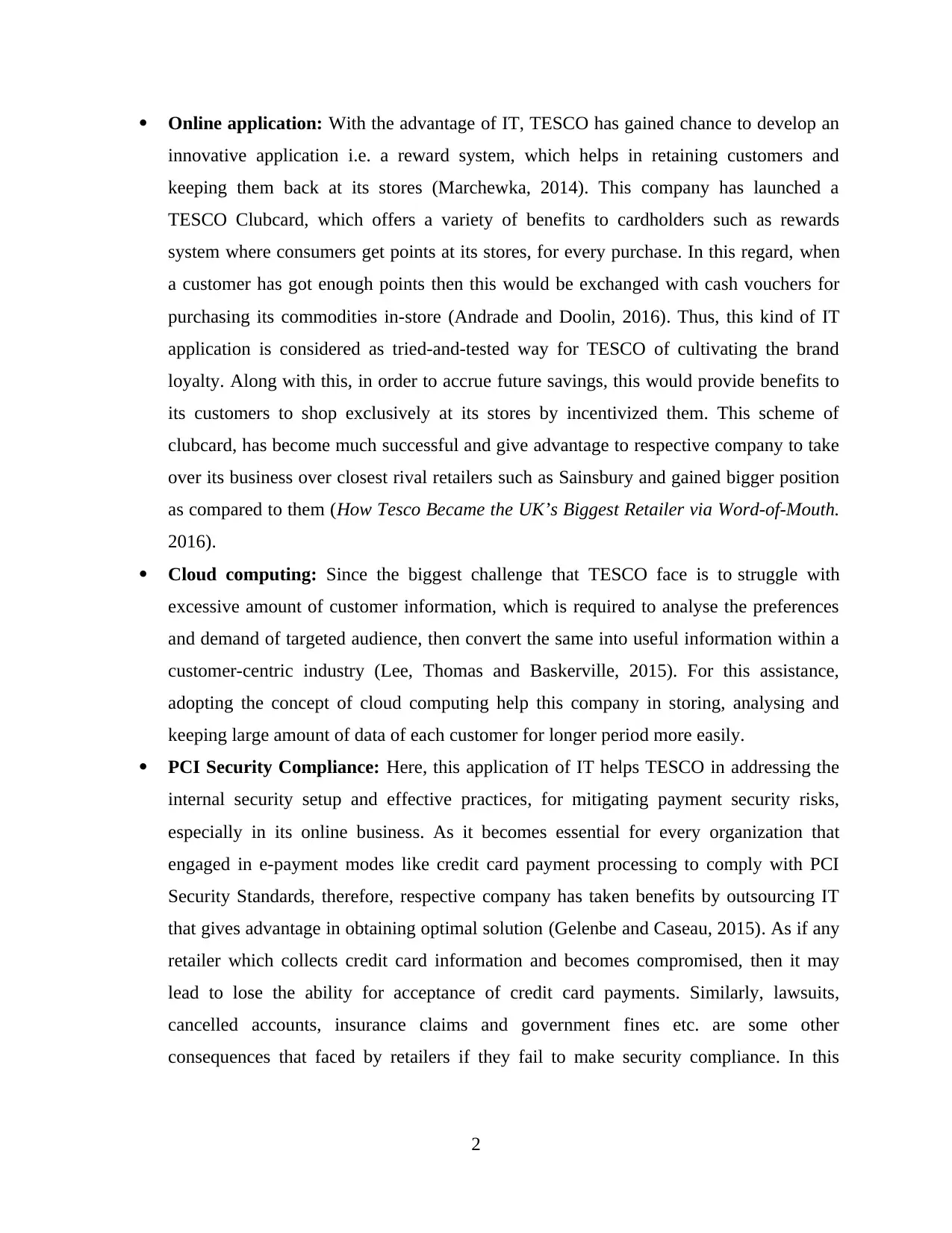
Online application: With the advantage of IT, TESCO has gained chance to develop an
innovative application i.e. a reward system, which helps in retaining customers and
keeping them back at its stores (Marchewka, 2014). This company has launched a
TESCO Clubcard, which offers a variety of benefits to cardholders such as rewards
system where consumers get points at its stores, for every purchase. In this regard, when
a customer has got enough points then this would be exchanged with cash vouchers for
purchasing its commodities in-store (Andrade and Doolin, 2016). Thus, this kind of IT
application is considered as tried-and-tested way for TESCO of cultivating the brand
loyalty. Along with this, in order to accrue future savings, this would provide benefits to
its customers to shop exclusively at its stores by incentivized them. This scheme of
clubcard, has become much successful and give advantage to respective company to take
over its business over closest rival retailers such as Sainsbury and gained bigger position
as compared to them (How Tesco Became the UK’s Biggest Retailer via Word-of-Mouth.
2016).
Cloud computing: Since the biggest challenge that TESCO face is to struggle with
excessive amount of customer information, which is required to analyse the preferences
and demand of targeted audience, then convert the same into useful information within a
customer-centric industry (Lee, Thomas and Baskerville, 2015). For this assistance,
adopting the concept of cloud computing help this company in storing, analysing and
keeping large amount of data of each customer for longer period more easily.
PCI Security Compliance: Here, this application of IT helps TESCO in addressing the
internal security setup and effective practices, for mitigating payment security risks,
especially in its online business. As it becomes essential for every organization that
engaged in e-payment modes like credit card payment processing to comply with PCI
Security Standards, therefore, respective company has taken benefits by outsourcing IT
that gives advantage in obtaining optimal solution (Gelenbe and Caseau, 2015). As if any
retailer which collects credit card information and becomes compromised, then it may
lead to lose the ability for acceptance of credit card payments. Similarly, lawsuits,
cancelled accounts, insurance claims and government fines etc. are some other
consequences that faced by retailers if they fail to make security compliance. In this
2
innovative application i.e. a reward system, which helps in retaining customers and
keeping them back at its stores (Marchewka, 2014). This company has launched a
TESCO Clubcard, which offers a variety of benefits to cardholders such as rewards
system where consumers get points at its stores, for every purchase. In this regard, when
a customer has got enough points then this would be exchanged with cash vouchers for
purchasing its commodities in-store (Andrade and Doolin, 2016). Thus, this kind of IT
application is considered as tried-and-tested way for TESCO of cultivating the brand
loyalty. Along with this, in order to accrue future savings, this would provide benefits to
its customers to shop exclusively at its stores by incentivized them. This scheme of
clubcard, has become much successful and give advantage to respective company to take
over its business over closest rival retailers such as Sainsbury and gained bigger position
as compared to them (How Tesco Became the UK’s Biggest Retailer via Word-of-Mouth.
2016).
Cloud computing: Since the biggest challenge that TESCO face is to struggle with
excessive amount of customer information, which is required to analyse the preferences
and demand of targeted audience, then convert the same into useful information within a
customer-centric industry (Lee, Thomas and Baskerville, 2015). For this assistance,
adopting the concept of cloud computing help this company in storing, analysing and
keeping large amount of data of each customer for longer period more easily.
PCI Security Compliance: Here, this application of IT helps TESCO in addressing the
internal security setup and effective practices, for mitigating payment security risks,
especially in its online business. As it becomes essential for every organization that
engaged in e-payment modes like credit card payment processing to comply with PCI
Security Standards, therefore, respective company has taken benefits by outsourcing IT
that gives advantage in obtaining optimal solution (Gelenbe and Caseau, 2015). As if any
retailer which collects credit card information and becomes compromised, then it may
lead to lose the ability for acceptance of credit card payments. Similarly, lawsuits,
cancelled accounts, insurance claims and government fines etc. are some other
consequences that faced by retailers if they fail to make security compliance. In this
2
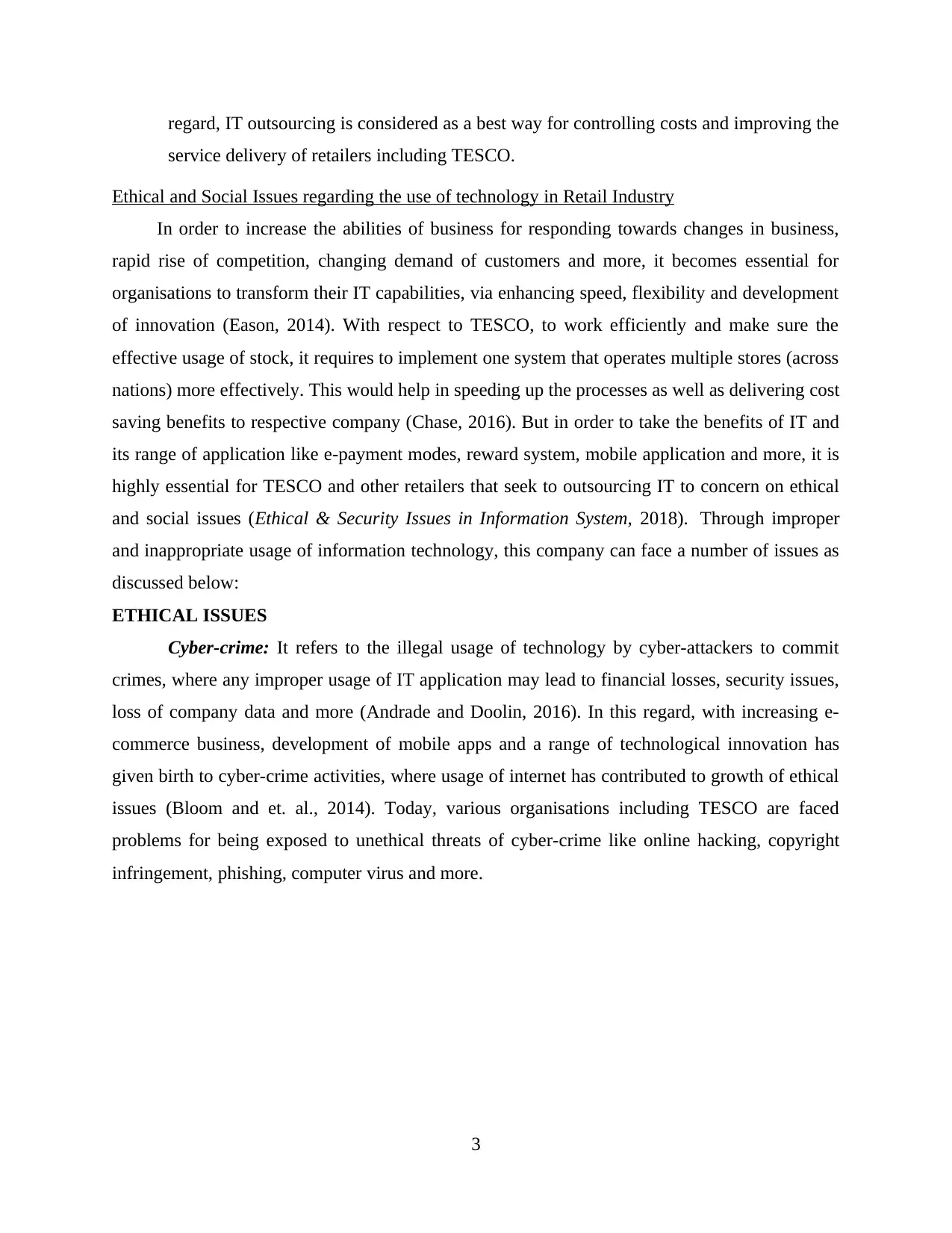
regard, IT outsourcing is considered as a best way for controlling costs and improving the
service delivery of retailers including TESCO.
Ethical and Social Issues regarding the use of technology in Retail Industry
In order to increase the abilities of business for responding towards changes in business,
rapid rise of competition, changing demand of customers and more, it becomes essential for
organisations to transform their IT capabilities, via enhancing speed, flexibility and development
of innovation (Eason, 2014). With respect to TESCO, to work efficiently and make sure the
effective usage of stock, it requires to implement one system that operates multiple stores (across
nations) more effectively. This would help in speeding up the processes as well as delivering cost
saving benefits to respective company (Chase, 2016). But in order to take the benefits of IT and
its range of application like e-payment modes, reward system, mobile application and more, it is
highly essential for TESCO and other retailers that seek to outsourcing IT to concern on ethical
and social issues (Ethical & Security Issues in Information System, 2018). Through improper
and inappropriate usage of information technology, this company can face a number of issues as
discussed below:
ETHICAL ISSUES
Cyber-crime: It refers to the illegal usage of technology by cyber-attackers to commit
crimes, where any improper usage of IT application may lead to financial losses, security issues,
loss of company data and more (Andrade and Doolin, 2016). In this regard, with increasing e-
commerce business, development of mobile apps and a range of technological innovation has
given birth to cyber-crime activities, where usage of internet has contributed to growth of ethical
issues (Bloom and et. al., 2014). Today, various organisations including TESCO are faced
problems for being exposed to unethical threats of cyber-crime like online hacking, copyright
infringement, phishing, computer virus and more.
3
service delivery of retailers including TESCO.
Ethical and Social Issues regarding the use of technology in Retail Industry
In order to increase the abilities of business for responding towards changes in business,
rapid rise of competition, changing demand of customers and more, it becomes essential for
organisations to transform their IT capabilities, via enhancing speed, flexibility and development
of innovation (Eason, 2014). With respect to TESCO, to work efficiently and make sure the
effective usage of stock, it requires to implement one system that operates multiple stores (across
nations) more effectively. This would help in speeding up the processes as well as delivering cost
saving benefits to respective company (Chase, 2016). But in order to take the benefits of IT and
its range of application like e-payment modes, reward system, mobile application and more, it is
highly essential for TESCO and other retailers that seek to outsourcing IT to concern on ethical
and social issues (Ethical & Security Issues in Information System, 2018). Through improper
and inappropriate usage of information technology, this company can face a number of issues as
discussed below:
ETHICAL ISSUES
Cyber-crime: It refers to the illegal usage of technology by cyber-attackers to commit
crimes, where any improper usage of IT application may lead to financial losses, security issues,
loss of company data and more (Andrade and Doolin, 2016). In this regard, with increasing e-
commerce business, development of mobile apps and a range of technological innovation has
given birth to cyber-crime activities, where usage of internet has contributed to growth of ethical
issues (Bloom and et. al., 2014). Today, various organisations including TESCO are faced
problems for being exposed to unethical threats of cyber-crime like online hacking, copyright
infringement, phishing, computer virus and more.
3
⊘ This is a preview!⊘
Do you want full access?
Subscribe today to unlock all pages.

Trusted by 1+ million students worldwide
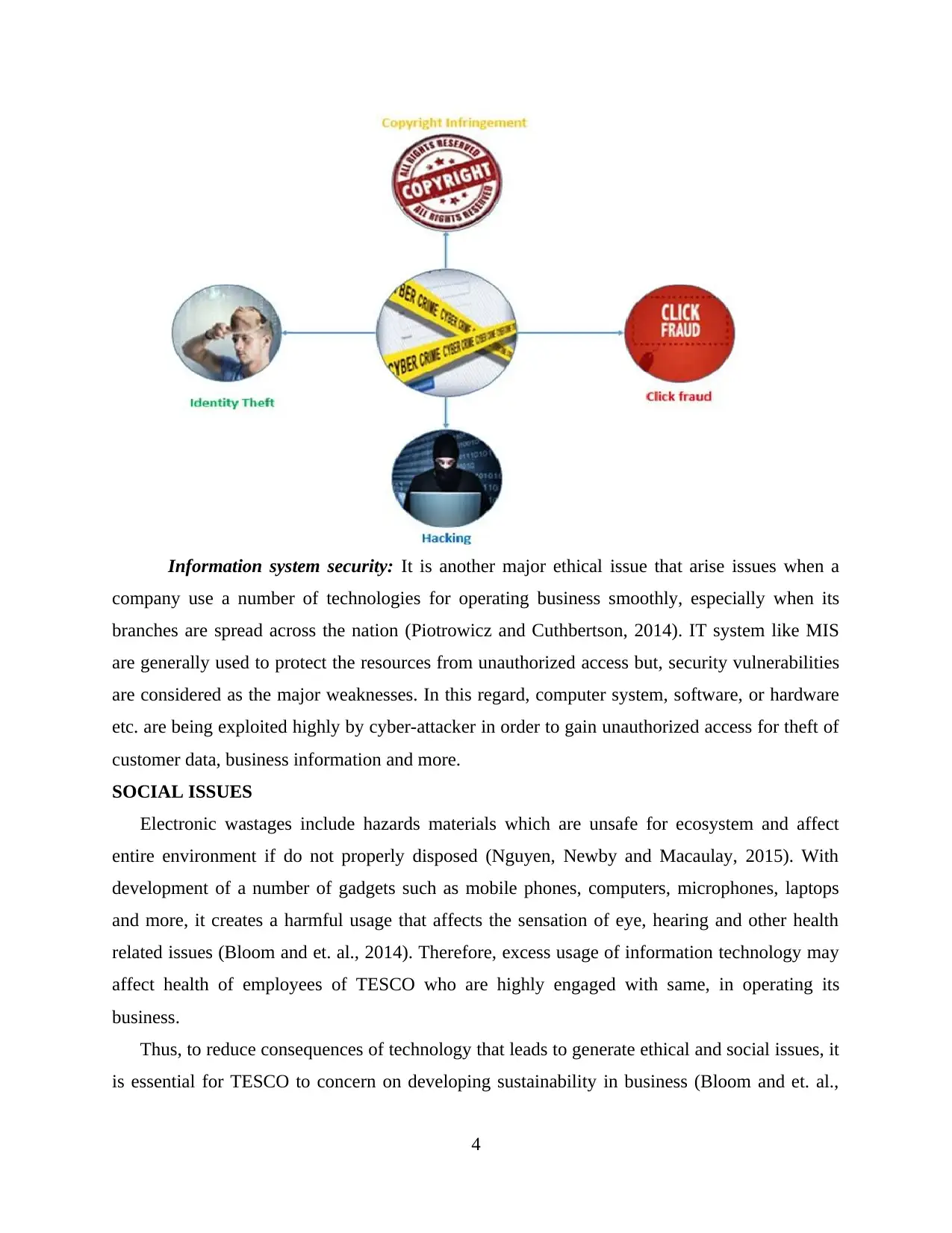
Information system security: It is another major ethical issue that arise issues when a
company use a number of technologies for operating business smoothly, especially when its
branches are spread across the nation (Piotrowicz and Cuthbertson, 2014). IT system like MIS
are generally used to protect the resources from unauthorized access but, security vulnerabilities
are considered as the major weaknesses. In this regard, computer system, software, or hardware
etc. are being exploited highly by cyber-attacker in order to gain unauthorized access for theft of
customer data, business information and more.
SOCIAL ISSUES
Electronic wastages include hazards materials which are unsafe for ecosystem and affect
entire environment if do not properly disposed (Nguyen, Newby and Macaulay, 2015). With
development of a number of gadgets such as mobile phones, computers, microphones, laptops
and more, it creates a harmful usage that affects the sensation of eye, hearing and other health
related issues (Bloom and et. al., 2014). Therefore, excess usage of information technology may
affect health of employees of TESCO who are highly engaged with same, in operating its
business.
Thus, to reduce consequences of technology that leads to generate ethical and social issues, it
is essential for TESCO to concern on developing sustainability in business (Bloom and et. al.,
4
company use a number of technologies for operating business smoothly, especially when its
branches are spread across the nation (Piotrowicz and Cuthbertson, 2014). IT system like MIS
are generally used to protect the resources from unauthorized access but, security vulnerabilities
are considered as the major weaknesses. In this regard, computer system, software, or hardware
etc. are being exploited highly by cyber-attacker in order to gain unauthorized access for theft of
customer data, business information and more.
SOCIAL ISSUES
Electronic wastages include hazards materials which are unsafe for ecosystem and affect
entire environment if do not properly disposed (Nguyen, Newby and Macaulay, 2015). With
development of a number of gadgets such as mobile phones, computers, microphones, laptops
and more, it creates a harmful usage that affects the sensation of eye, hearing and other health
related issues (Bloom and et. al., 2014). Therefore, excess usage of information technology may
affect health of employees of TESCO who are highly engaged with same, in operating its
business.
Thus, to reduce consequences of technology that leads to generate ethical and social issues, it
is essential for TESCO to concern on developing sustainability in business (Bloom and et. al.,
4
Paraphrase This Document
Need a fresh take? Get an instant paraphrase of this document with our AI Paraphraser
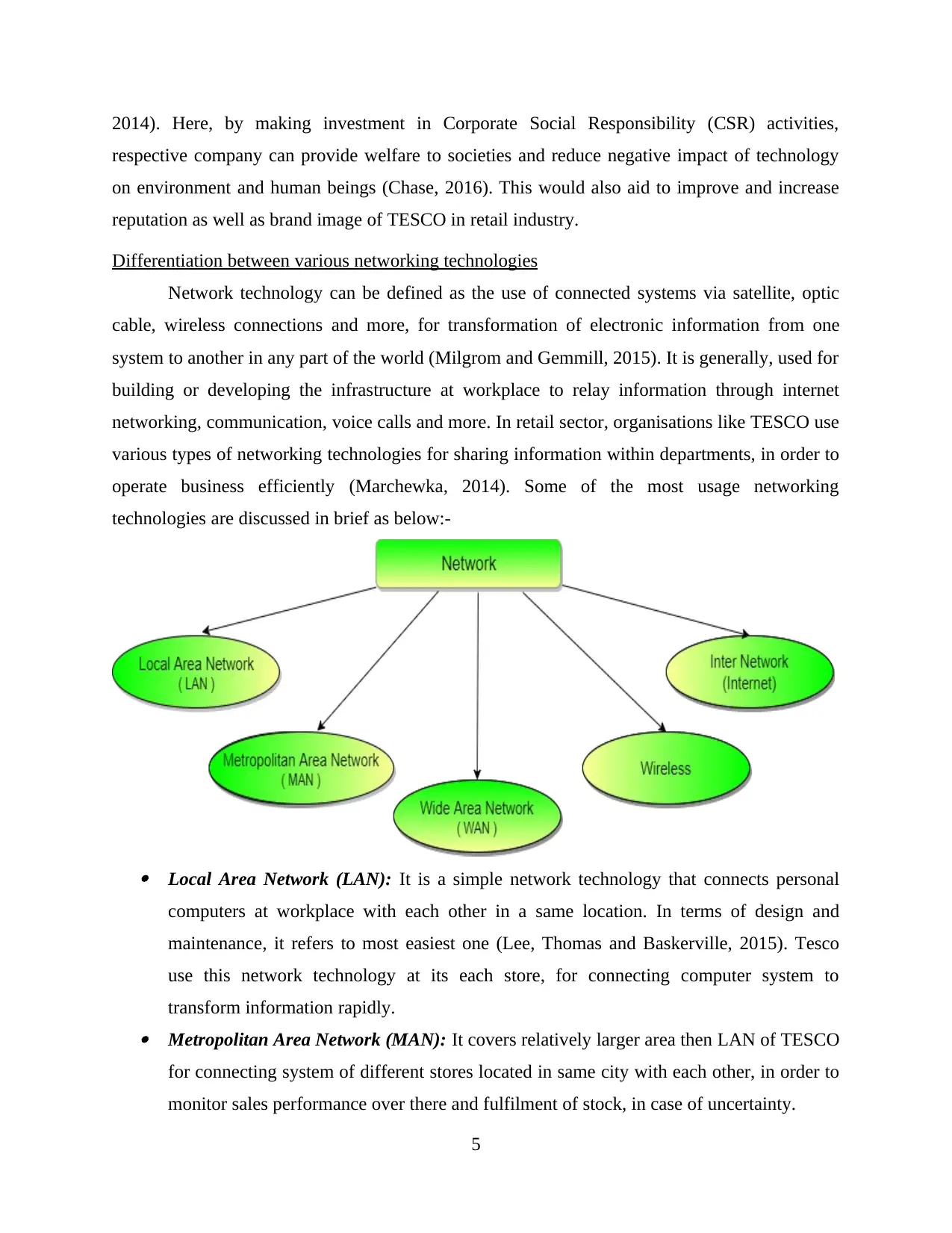
2014). Here, by making investment in Corporate Social Responsibility (CSR) activities,
respective company can provide welfare to societies and reduce negative impact of technology
on environment and human beings (Chase, 2016). This would also aid to improve and increase
reputation as well as brand image of TESCO in retail industry.
Differentiation between various networking technologies
Network technology can be defined as the use of connected systems via satellite, optic
cable, wireless connections and more, for transformation of electronic information from one
system to another in any part of the world (Milgrom and Gemmill, 2015). It is generally, used for
building or developing the infrastructure at workplace to relay information through internet
networking, communication, voice calls and more. In retail sector, organisations like TESCO use
various types of networking technologies for sharing information within departments, in order to
operate business efficiently (Marchewka, 2014). Some of the most usage networking
technologies are discussed in brief as below:-
Local Area Network (LAN): It is a simple network technology that connects personal
computers at workplace with each other in a same location. In terms of design and
maintenance, it refers to most easiest one (Lee, Thomas and Baskerville, 2015). Tesco
use this network technology at its each store, for connecting computer system to
transform information rapidly. Metropolitan Area Network (MAN): It covers relatively larger area then LAN of TESCO
for connecting system of different stores located in same city with each other, in order to
monitor sales performance over there and fulfilment of stock, in case of uncertainty.
5
respective company can provide welfare to societies and reduce negative impact of technology
on environment and human beings (Chase, 2016). This would also aid to improve and increase
reputation as well as brand image of TESCO in retail industry.
Differentiation between various networking technologies
Network technology can be defined as the use of connected systems via satellite, optic
cable, wireless connections and more, for transformation of electronic information from one
system to another in any part of the world (Milgrom and Gemmill, 2015). It is generally, used for
building or developing the infrastructure at workplace to relay information through internet
networking, communication, voice calls and more. In retail sector, organisations like TESCO use
various types of networking technologies for sharing information within departments, in order to
operate business efficiently (Marchewka, 2014). Some of the most usage networking
technologies are discussed in brief as below:-
Local Area Network (LAN): It is a simple network technology that connects personal
computers at workplace with each other in a same location. In terms of design and
maintenance, it refers to most easiest one (Lee, Thomas and Baskerville, 2015). Tesco
use this network technology at its each store, for connecting computer system to
transform information rapidly. Metropolitan Area Network (MAN): It covers relatively larger area then LAN of TESCO
for connecting system of different stores located in same city with each other, in order to
monitor sales performance over there and fulfilment of stock, in case of uncertainty.
5
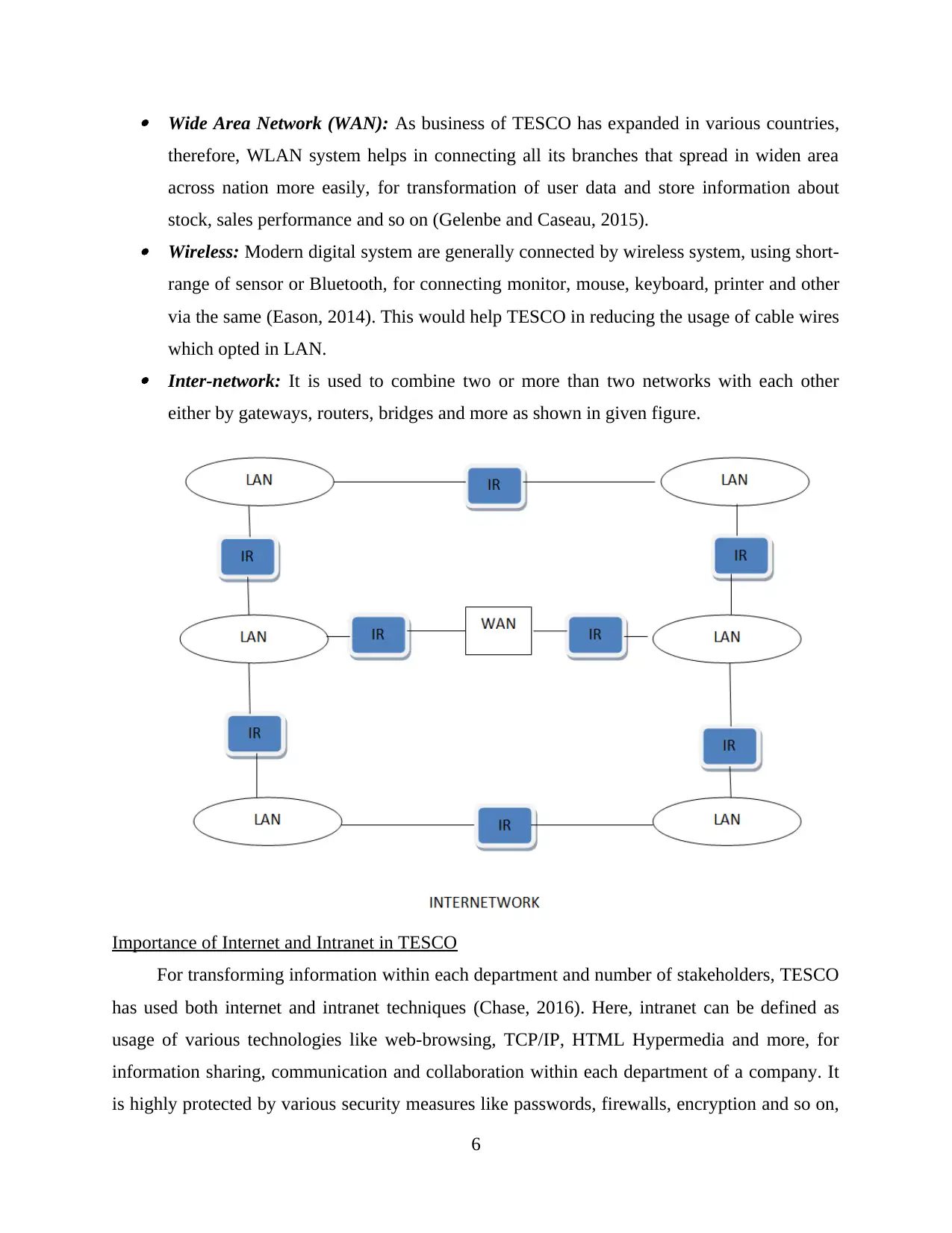
Wide Area Network (WAN): As business of TESCO has expanded in various countries,
therefore, WLAN system helps in connecting all its branches that spread in widen area
across nation more easily, for transformation of user data and store information about
stock, sales performance and so on (Gelenbe and Caseau, 2015). Wireless: Modern digital system are generally connected by wireless system, using short-
range of sensor or Bluetooth, for connecting monitor, mouse, keyboard, printer and other
via the same (Eason, 2014). This would help TESCO in reducing the usage of cable wires
which opted in LAN. Inter-network: It is used to combine two or more than two networks with each other
either by gateways, routers, bridges and more as shown in given figure.
Importance of Internet and Intranet in TESCO
For transforming information within each department and number of stakeholders, TESCO
has used both internet and intranet techniques (Chase, 2016). Here, intranet can be defined as
usage of various technologies like web-browsing, TCP/IP, HTML Hypermedia and more, for
information sharing, communication and collaboration within each department of a company. It
is highly protected by various security measures like passwords, firewalls, encryption and so on,
6
therefore, WLAN system helps in connecting all its branches that spread in widen area
across nation more easily, for transformation of user data and store information about
stock, sales performance and so on (Gelenbe and Caseau, 2015). Wireless: Modern digital system are generally connected by wireless system, using short-
range of sensor or Bluetooth, for connecting monitor, mouse, keyboard, printer and other
via the same (Eason, 2014). This would help TESCO in reducing the usage of cable wires
which opted in LAN. Inter-network: It is used to combine two or more than two networks with each other
either by gateways, routers, bridges and more as shown in given figure.
Importance of Internet and Intranet in TESCO
For transforming information within each department and number of stakeholders, TESCO
has used both internet and intranet techniques (Chase, 2016). Here, intranet can be defined as
usage of various technologies like web-browsing, TCP/IP, HTML Hypermedia and more, for
information sharing, communication and collaboration within each department of a company. It
is highly protected by various security measures like passwords, firewalls, encryption and so on,
6
⊘ This is a preview!⊘
Do you want full access?
Subscribe today to unlock all pages.

Trusted by 1+ million students worldwide
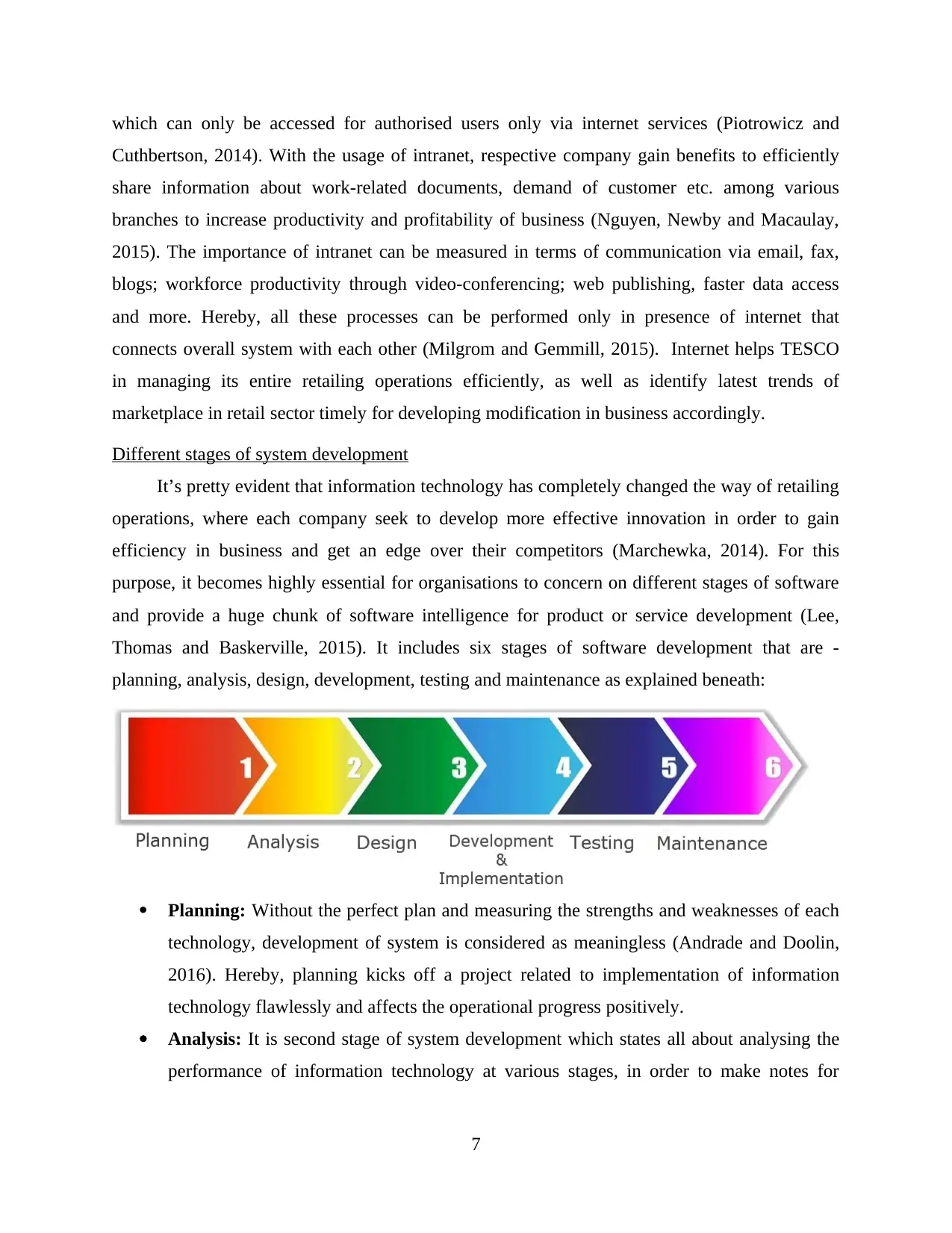
which can only be accessed for authorised users only via internet services (Piotrowicz and
Cuthbertson, 2014). With the usage of intranet, respective company gain benefits to efficiently
share information about work-related documents, demand of customer etc. among various
branches to increase productivity and profitability of business (Nguyen, Newby and Macaulay,
2015). The importance of intranet can be measured in terms of communication via email, fax,
blogs; workforce productivity through video-conferencing; web publishing, faster data access
and more. Hereby, all these processes can be performed only in presence of internet that
connects overall system with each other (Milgrom and Gemmill, 2015). Internet helps TESCO
in managing its entire retailing operations efficiently, as well as identify latest trends of
marketplace in retail sector timely for developing modification in business accordingly.
Different stages of system development
It’s pretty evident that information technology has completely changed the way of retailing
operations, where each company seek to develop more effective innovation in order to gain
efficiency in business and get an edge over their competitors (Marchewka, 2014). For this
purpose, it becomes highly essential for organisations to concern on different stages of software
and provide a huge chunk of software intelligence for product or service development (Lee,
Thomas and Baskerville, 2015). It includes six stages of software development that are -
planning, analysis, design, development, testing and maintenance as explained beneath:
Planning: Without the perfect plan and measuring the strengths and weaknesses of each
technology, development of system is considered as meaningless (Andrade and Doolin,
2016). Hereby, planning kicks off a project related to implementation of information
technology flawlessly and affects the operational progress positively.
Analysis: It is second stage of system development which states all about analysing the
performance of information technology at various stages, in order to make notes for
7
Cuthbertson, 2014). With the usage of intranet, respective company gain benefits to efficiently
share information about work-related documents, demand of customer etc. among various
branches to increase productivity and profitability of business (Nguyen, Newby and Macaulay,
2015). The importance of intranet can be measured in terms of communication via email, fax,
blogs; workforce productivity through video-conferencing; web publishing, faster data access
and more. Hereby, all these processes can be performed only in presence of internet that
connects overall system with each other (Milgrom and Gemmill, 2015). Internet helps TESCO
in managing its entire retailing operations efficiently, as well as identify latest trends of
marketplace in retail sector timely for developing modification in business accordingly.
Different stages of system development
It’s pretty evident that information technology has completely changed the way of retailing
operations, where each company seek to develop more effective innovation in order to gain
efficiency in business and get an edge over their competitors (Marchewka, 2014). For this
purpose, it becomes highly essential for organisations to concern on different stages of software
and provide a huge chunk of software intelligence for product or service development (Lee,
Thomas and Baskerville, 2015). It includes six stages of software development that are -
planning, analysis, design, development, testing and maintenance as explained beneath:
Planning: Without the perfect plan and measuring the strengths and weaknesses of each
technology, development of system is considered as meaningless (Andrade and Doolin,
2016). Hereby, planning kicks off a project related to implementation of information
technology flawlessly and affects the operational progress positively.
Analysis: It is second stage of system development which states all about analysing the
performance of information technology at various stages, in order to make notes for
7
Paraphrase This Document
Need a fresh take? Get an instant paraphrase of this document with our AI Paraphraser
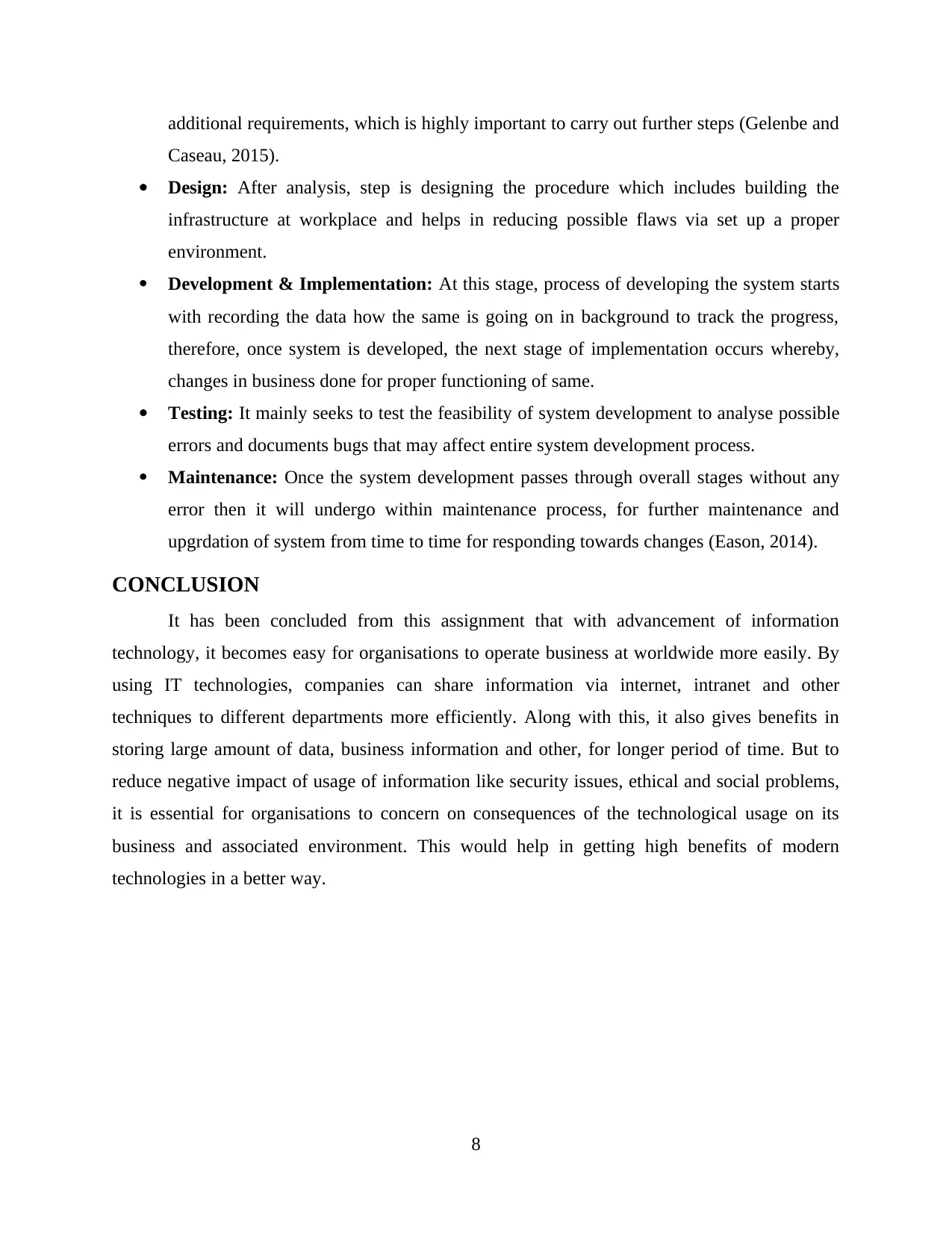
additional requirements, which is highly important to carry out further steps (Gelenbe and
Caseau, 2015).
Design: After analysis, step is designing the procedure which includes building the
infrastructure at workplace and helps in reducing possible flaws via set up a proper
environment.
Development & Implementation: At this stage, process of developing the system starts
with recording the data how the same is going on in background to track the progress,
therefore, once system is developed, the next stage of implementation occurs whereby,
changes in business done for proper functioning of same.
Testing: It mainly seeks to test the feasibility of system development to analyse possible
errors and documents bugs that may affect entire system development process.
Maintenance: Once the system development passes through overall stages without any
error then it will undergo within maintenance process, for further maintenance and
upgrdation of system from time to time for responding towards changes (Eason, 2014).
CONCLUSION
It has been concluded from this assignment that with advancement of information
technology, it becomes easy for organisations to operate business at worldwide more easily. By
using IT technologies, companies can share information via internet, intranet and other
techniques to different departments more efficiently. Along with this, it also gives benefits in
storing large amount of data, business information and other, for longer period of time. But to
reduce negative impact of usage of information like security issues, ethical and social problems,
it is essential for organisations to concern on consequences of the technological usage on its
business and associated environment. This would help in getting high benefits of modern
technologies in a better way.
8
Caseau, 2015).
Design: After analysis, step is designing the procedure which includes building the
infrastructure at workplace and helps in reducing possible flaws via set up a proper
environment.
Development & Implementation: At this stage, process of developing the system starts
with recording the data how the same is going on in background to track the progress,
therefore, once system is developed, the next stage of implementation occurs whereby,
changes in business done for proper functioning of same.
Testing: It mainly seeks to test the feasibility of system development to analyse possible
errors and documents bugs that may affect entire system development process.
Maintenance: Once the system development passes through overall stages without any
error then it will undergo within maintenance process, for further maintenance and
upgrdation of system from time to time for responding towards changes (Eason, 2014).
CONCLUSION
It has been concluded from this assignment that with advancement of information
technology, it becomes easy for organisations to operate business at worldwide more easily. By
using IT technologies, companies can share information via internet, intranet and other
techniques to different departments more efficiently. Along with this, it also gives benefits in
storing large amount of data, business information and other, for longer period of time. But to
reduce negative impact of usage of information like security issues, ethical and social problems,
it is essential for organisations to concern on consequences of the technological usage on its
business and associated environment. This would help in getting high benefits of modern
technologies in a better way.
8
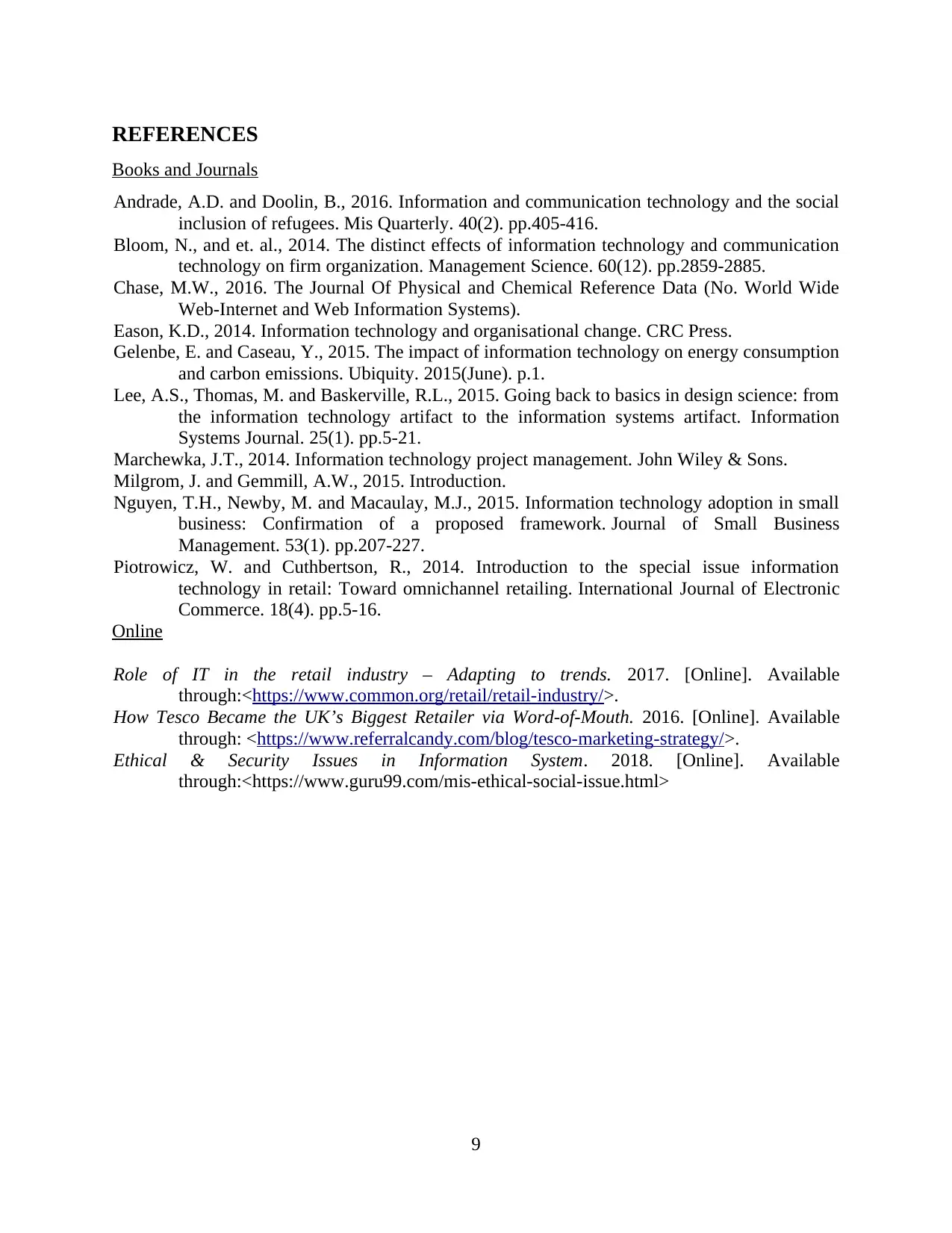
REFERENCES
Books and Journals
Andrade, A.D. and Doolin, B., 2016. Information and communication technology and the social
inclusion of refugees. Mis Quarterly. 40(2). pp.405-416.
Bloom, N., and et. al., 2014. The distinct effects of information technology and communication
technology on firm organization. Management Science. 60(12). pp.2859-2885.
Chase, M.W., 2016. The Journal Of Physical and Chemical Reference Data (No. World Wide
Web-Internet and Web Information Systems).
Eason, K.D., 2014. Information technology and organisational change. CRC Press.
Gelenbe, E. and Caseau, Y., 2015. The impact of information technology on energy consumption
and carbon emissions. Ubiquity. 2015(June). p.1.
Lee, A.S., Thomas, M. and Baskerville, R.L., 2015. Going back to basics in design science: from
the information technology artifact to the information systems artifact. Information
Systems Journal. 25(1). pp.5-21.
Marchewka, J.T., 2014. Information technology project management. John Wiley & Sons.
Milgrom, J. and Gemmill, A.W., 2015. Introduction.
Nguyen, T.H., Newby, M. and Macaulay, M.J., 2015. Information technology adoption in small
business: Confirmation of a proposed framework. Journal of Small Business
Management. 53(1). pp.207-227.
Piotrowicz, W. and Cuthbertson, R., 2014. Introduction to the special issue information
technology in retail: Toward omnichannel retailing. International Journal of Electronic
Commerce. 18(4). pp.5-16.
Online
Role of IT in the retail industry – Adapting to trends. 2017. [Online]. Available
through:<https://www.common.org/retail/retail-industry/>.
How Tesco Became the UK’s Biggest Retailer via Word-of-Mouth. 2016. [Online]. Available
through: <https://www.referralcandy.com/blog/tesco-marketing-strategy/>.
Ethical & Security Issues in Information System. 2018. [Online]. Available
through:<https://www.guru99.com/mis-ethical-social-issue.html>
9
Books and Journals
Andrade, A.D. and Doolin, B., 2016. Information and communication technology and the social
inclusion of refugees. Mis Quarterly. 40(2). pp.405-416.
Bloom, N., and et. al., 2014. The distinct effects of information technology and communication
technology on firm organization. Management Science. 60(12). pp.2859-2885.
Chase, M.W., 2016. The Journal Of Physical and Chemical Reference Data (No. World Wide
Web-Internet and Web Information Systems).
Eason, K.D., 2014. Information technology and organisational change. CRC Press.
Gelenbe, E. and Caseau, Y., 2015. The impact of information technology on energy consumption
and carbon emissions. Ubiquity. 2015(June). p.1.
Lee, A.S., Thomas, M. and Baskerville, R.L., 2015. Going back to basics in design science: from
the information technology artifact to the information systems artifact. Information
Systems Journal. 25(1). pp.5-21.
Marchewka, J.T., 2014. Information technology project management. John Wiley & Sons.
Milgrom, J. and Gemmill, A.W., 2015. Introduction.
Nguyen, T.H., Newby, M. and Macaulay, M.J., 2015. Information technology adoption in small
business: Confirmation of a proposed framework. Journal of Small Business
Management. 53(1). pp.207-227.
Piotrowicz, W. and Cuthbertson, R., 2014. Introduction to the special issue information
technology in retail: Toward omnichannel retailing. International Journal of Electronic
Commerce. 18(4). pp.5-16.
Online
Role of IT in the retail industry – Adapting to trends. 2017. [Online]. Available
through:<https://www.common.org/retail/retail-industry/>.
How Tesco Became the UK’s Biggest Retailer via Word-of-Mouth. 2016. [Online]. Available
through: <https://www.referralcandy.com/blog/tesco-marketing-strategy/>.
Ethical & Security Issues in Information System. 2018. [Online]. Available
through:<https://www.guru99.com/mis-ethical-social-issue.html>
9
⊘ This is a preview!⊘
Do you want full access?
Subscribe today to unlock all pages.

Trusted by 1+ million students worldwide
1 out of 12
Related Documents
Your All-in-One AI-Powered Toolkit for Academic Success.
+13062052269
info@desklib.com
Available 24*7 on WhatsApp / Email
![[object Object]](/_next/static/media/star-bottom.7253800d.svg)
Unlock your academic potential
Copyright © 2020–2025 A2Z Services. All Rights Reserved. Developed and managed by ZUCOL.





